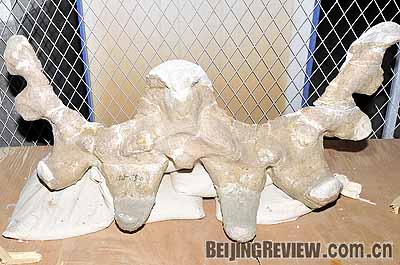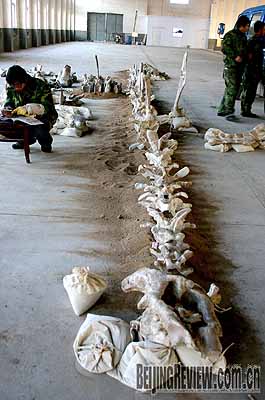|
|
 |
|
NEW DISCOVERY: Researchers try to rearrange the fossilized bones of a large hadrosaurus recently unearthed in Zhucheng (ZHU ZHENG) | Chinese scientists claim to have discovered the world's largest dinosaur fossil site in eastern Shandong Province, which is expected to shed light on the animal's mysterious extinction toward the end of the Cretaceous Period 65 million years ago.
In Zhucheng, known as China's dinosaur city, more than 7,600 fossils were unearthed in the seven months between March and October 2008 from 15 separate sites. The final number of fossils will be much larger after excavations are resumed when the weather gets warmer, according to Zhao Xijin, a paleontologist from the Institute of Vertebrate Paleontology and Paleoanthropology of the Chinese Academy of Sciences, who is in charge of the project.
The large-scale dinosaur fossil excavation is the third one in this city since a major field of large fossils of hadrosaurus, or a "duck-billed" dinosaur, was discovered there in the 1960s by an oil expedition. More than 50 tons of fossils have been discovered since then. The world's largest hadrosaurus fossil was found in Zhucheng in the 1980s and exhibited in the local museum.
|
 |
|
EXOTIC CREATURE: The 2-meter skull of a large ceratopsian recently unearthed in Zhucheng is the first of its kind discovered outside North America (ZHU ZHENG) | The most productive site is along a 300-meter-long and five-meter-wide slope on the outskirts of the city, where over 3,000 fossils have been excavated. Zhao told Xinhua News Agency this group of dinosaur fossils is currently the largest ever discovered in the world in terms of area.
"The discoveries are expected to contribute to research on the mystery of dinosaur extinction," Zhao said. He added that the fossils dated mainly from the Late Cretaceous of the Mesozoic Period, when dinosaurs were becoming extinct. "Study of the unearthed fossils will provide a lot of scientific evidence to understand the climate, geological conditions, environmental changes and biological evolution in the Late Cretaceous," Zhao said. Among theories to explain dinosaur extinction, the most widely accepted ones include an asteroid crash in the Gulf of Mexico, extreme weather, the spread of diseases across newly united continents and volcanic eruptions.
|
